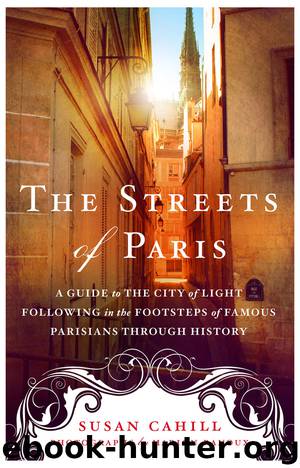The Streets of Paris by Susan Cahill

Author:Susan Cahill
Language: eng
Format: epub
Publisher: St. Martin's Press
Alberto Giacometti: Rue des Thermopyles
ALBERTO GIACOMETTI: WHAT YOU SEE IS WHAT THERE IS
LOCATION: 46, rue Hippolyte-Maindron, Studio
MÉTRO: Pernety
As a schoolboy, Giacometti (1901–1966) was admired as a talented artist and brilliant student. He would become, in the words of art critic John Berger, “a most extreme artist,” a contemplative sculptor and painter who believed that “no reality could ever be shared.”
He grew up in a close family in a small village in the alpine valley of Bregaglia in southeastern Switzerland, about twelve miles from the Italian border. From November until February the high mountain walls along the valley cut off all sunlight. Alberto, born in October as the sunless, austere season got underway, had a profound connection with this place and his mother that lasted through both their lifetimes. As a child, his dearest friends were stones (more like boulders), a cave, and trees, the material of his future art. He loved to sit and read and illustrate his storybooks in his painter/father’s studio; he loved the art of Dürer and Rembrandt. At fourteen, returning home from boarding school for vacation, he spent his train money on a book of Rodin reproductions, which meant he had to walk ten miles over the Alps carrying his precious book. At fourteen, he made his first sculpture, of his brother Diego’s head.
Before he finally moved to Paris in 1922 just after his twentieth birthday, he had studied in Geneva, which he disliked, Venice (Women of Venice would be one of his most renowned masterpieces), Florence, and Rome where he fell in love and began to visit brothels. He also developed some themes of his lifework: the universe now became alien, beyond his own self, altogether incomprehensible. Reality is unknowable. His later friend and walking companion, Samuel Beckett, agreed. Some artists, according to Giacometti, achieve a partial view; most stay blind. He was no Cartesian. Seeing is being. “The act of looking was like a form of prayer for him … a way of approaching but never being able to grasp an absolute.”1
On his father’s suggestion that he go to Paris to study with Antoine Bourdelle (Rodin’s former assistant) at the Académie de la Grande-Chaumière, he worked for five years in Bourdelle’s studio though teacher and student were never simpatico. The evidence of their radically different vision and gifts is on exhibit in Bourdelle’s hard-to-find studio/museum north of the Gare Montparnasse (16, rue Antoine-Bourdelle, www.bourdelle.paris.fr) and in the many museums showing the sculpture and paintings of Giacometti (the Beaubourg, Musée d’Orsay, the Louvre, the Musée d’Art Moderne de la Ville de Paris, and others in New York, Chicago, Washington, D.C., London, Zürich, Rome, Turin, Venice, Vienna, etc.) Take a tour at www.fondationgiacometti.fr/en/16 discover -the-artwork/. Or google “Images from museums in Paris showing Alberto Giacometti’s sculpture and painting.”
Paris in the era when Giacometti arrived, just after World War I, had become the countercultural center of artistic life in Europe. Dada was the first of the movements formed to overturn traditional canons in visual and literary art,
Download
This site does not store any files on its server. We only index and link to content provided by other sites. Please contact the content providers to delete copyright contents if any and email us, we'll remove relevant links or contents immediately.
Spell It Out by David Crystal(35857)
Underground: A Human History of the Worlds Beneath Our Feet by Will Hunt(11846)
A Year in the Merde by Stephen Clarke(5082)
Venice by Jan Morris(2439)
Claridge's: The Cookbook by Nail Martyn & Erickson Meredith(2261)
My Paris Kitchen: Recipes and Stories by Lebovitz David(2135)
A TIME OF GIFTS by Patrick Leigh Fermor(2103)
The Plantagenets by Dan Jones(1935)
Welcome to the Goddamn Ice Cube by Blair Braverman(1889)
Bang Poland: How To Make Love With Polish Girls In Poland by Roosh V(1863)
Top 10 Prague (EYEWITNESS TOP 10 TRAVEL GUIDES) by DK(1854)
The Finnish Way by Katja Pantzar(1811)
The Isle of Mull by Terry Marsh(1807)
From Russia with Lunch by David Smiedt(1800)
A TIME TO KEEP SILENCE by Patrick Leigh Fermor(1775)
Rick Steves London 2018 by Rick Steves & Gene Openshaw(1752)
A Taste of Paris by David Downie(1747)
Merde in Europe by Stephen Clarke(1672)
Insight Guides Experience Tokyo by Insight Guides(1662)
